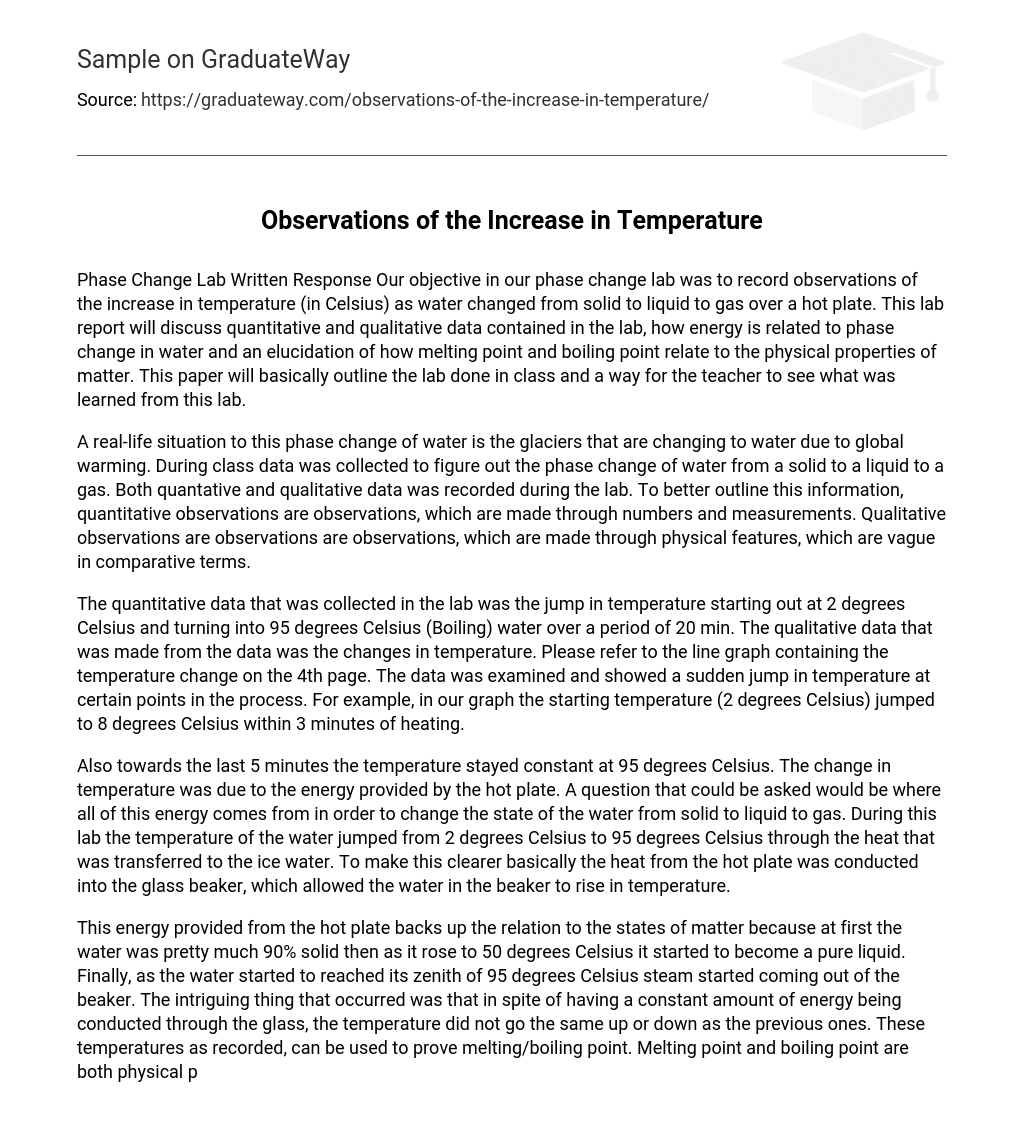Phase Change Lab Written Response Our objective in our phase change lab was to record observations of the increase in temperature (in Celsius) as water changed from solid to liquid to gas over a hot plate. This lab report will discuss quantitative and qualitative data contained in the lab, how energy is related to phase change in water and an elucidation of how melting point and boiling point relate to the physical properties of matter. This paper will basically outline the lab done in class and a way for the teacher to see what was learned from this lab.
A real-life situation to this phase change of water is the glaciers that are changing to water due to global warming. During class data was collected to figure out the phase change of water from a solid to a liquid to a gas. Both quantative and qualitative data was recorded during the lab. To better outline this information, quantitative observations are observations, which are made through numbers and measurements. Qualitative observations are observations are observations, which are made through physical features, which are vague in comparative terms.
The quantitative data that was collected in the lab was the jump in temperature starting out at 2 degrees Celsius and turning into 95 degrees Celsius (Boiling) water over a period of 20 min. The qualitative data that was made from the data was the changes in temperature. Please refer to the line graph containing the temperature change on the 4th page. The data was examined and showed a sudden jump in temperature at certain points in the process. For example, in our graph the starting temperature (2 degrees Celsius) jumped to 8 degrees Celsius within 3 minutes of heating.
Also towards the last 5 minutes the temperature stayed constant at 95 degrees Celsius. The change in temperature was due to the energy provided by the hot plate. A question that could be asked would be where all of this energy comes from in order to change the state of the water from solid to liquid to gas. During this lab the temperature of the water jumped from 2 degrees Celsius to 95 degrees Celsius through the heat that was transferred to the ice water. To make this clearer basically the heat from the hot plate was conducted into the glass beaker, which allowed the water in the beaker to rise in temperature.
This energy provided from the hot plate backs up the relation to the states of matter because at first the water was pretty much 90% solid then as it rose to 50 degrees Celsius it started to become a pure liquid. Finally, as the water started to reached its zenith of 95 degrees Celsius steam started coming out of the beaker. The intriguing thing that occurred was that in spite of having a constant amount of energy being conducted through the glass, the temperature did not go the same up or down as the previous ones. These temperatures as recorded, can be used to prove melting/boiling point. Melting point and boiling point are both physical properties although some may not know the definition of physical properties and the relation to the Melting/Boiling point of the liquid. To clarify this, physical properties are properties, which can be observed or measured without changing the composition of matter. They are mostly used to observe and describe matter. Physical properties can relate to the melting and boiling point of water because they can both be observed and measured without being changed. In addition, they are used to describe the state of matter.
According to scientists it has been discovered that the boiling point of water is 100 degrees Celsius and the freezing/melting point of water is 0 degrees Celsius. In our experiment the melting point was 2 degrees Celsius and the boiling point was 95 degrees Celsius. The larger difference was in the boiling point at a difference of 5 degrees and the lower difference was the melting point with a difference of 2 degrees Celsius. The main reason that the temperatures may be different than the actuals is due to the difference in altitude at sea level and in Denver which is 0 ft. s. 5280 ft. This will mainly affect the boiling point. Higher altitude decreases the boiling point of water. This is because the external atmospheric pressure is lower at higher altitudes, a lower vapor pressure of water is required for water to boil and therefore a lower temperature is required to achieve the desired vapor pressure. This report has discussed the quantitative and qualitative data collected in the lab, the evidence of energy used to prove how these changes relate to he changes of the states of matter. The objective of this lab was to record the temperature of water at different points as it was put on a hot plate at a constant temperature and reflect through a lab report discussing our observations. This objective was met by keeping a track of time and measurement on the thermometer. During this lab I found that with the amount of time given to us it was hard to make an accurate measurement and instead have to make a precise one.
This lab has introduced us to the changes in states of matter and much more which will probably lead into what we will be learning about Kinetic Molecular Theory next week. A real life application to the lab done this week could be the weather in cold places such as Denver. This is because if in Denver it is raining and then a cold front occurs then the weather changes from a liquid to a solid otherwise known as freezing rain. This concludes the information about this lab and outlines all of the above. Refer to Next page for Line graph *





